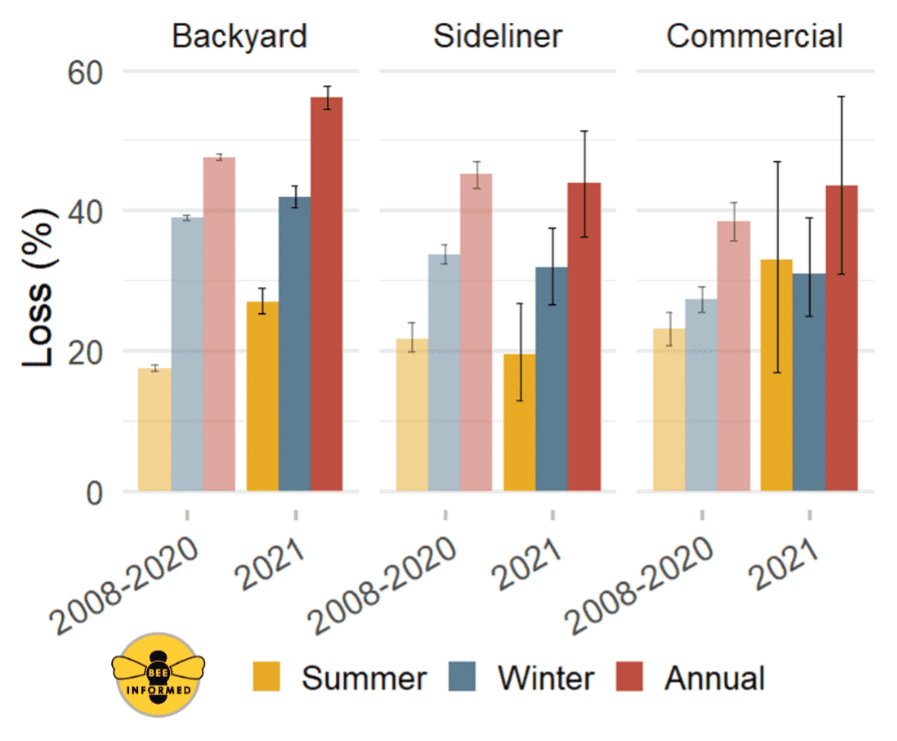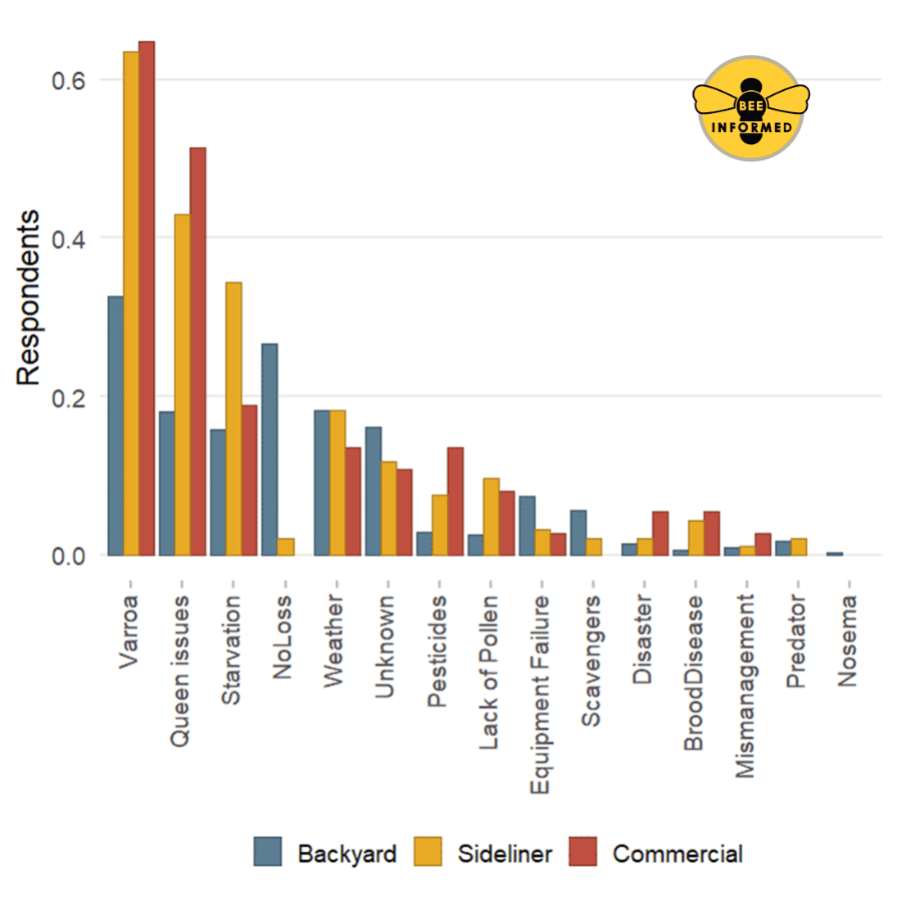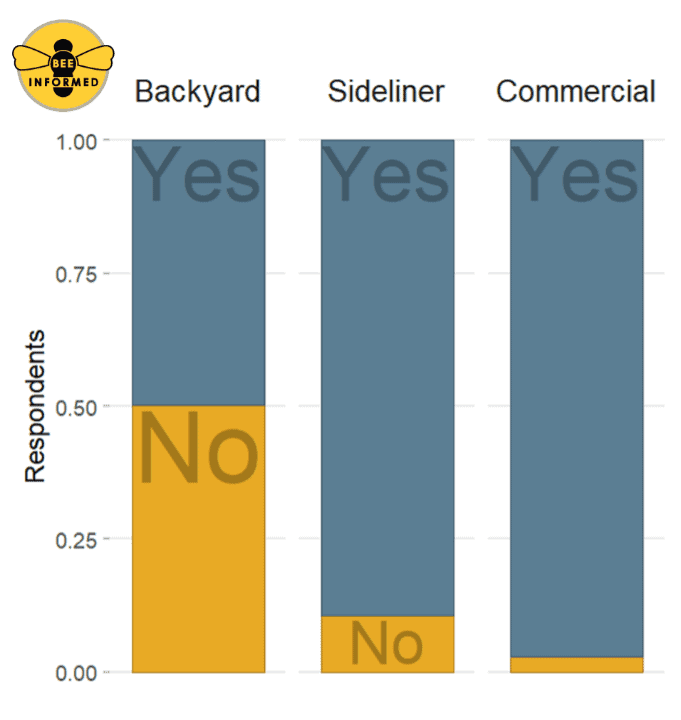Embargoed until Wednesday, June 23th, 2021, 12.00 PM Noon CST
Note: This is a preliminary analysis. Sample sizes and estimates are likely to change. A more detailed final report is being prepared for publication in a peer-reviewed journal at a later date.
Nathalie Steinhauer1, Dan Aurell2, Selina Bruckner2, Mikayla Wilson1, Karen Rennich1, Dennis vanEngelsdorp1, Geoffrey Williams2
1Department of Entomology, University of Maryland, College Park, MD, USA
2Department of Entomology & Plant Pathology, Auburn University, Auburn, AL, USA
Corresponding Authors: nsteinha@umd.edu (NS) & williams@auburn.edu (GW)
The Bee Informed Partnership (https://beeinformed.org) is a non-profit organization that works alongside beekeepers to improve honey bee colony health and survivorship across the United States. One of the organization’s longest running programs, the National Colony Loss and Management Survey was initiated with the support of the Apiary Inspectors of America in 2007. Since then, it has monitored managed honey bee colony loss rates, and identified risk factors and protective measures associated with beekeeping management (Steinhauer, vanEngelsdorp and Saegerman, 2021).
This year marks the fifteenth anniversary of the survey, which relies on voluntary participation of beekeepers across the country during the month of April. It covered the one year period between April 2020 and April 2021.
A total of 3,347 beekeepers from the United States that collectively managed 192,384 colonies on 1 October 2020 provided validated survey responses. This represented 7% of the estimated 2.71 million managed honey-producing colonies in the country in 2020 (USDA NASS, 2021).
Colony loss rates were calculated as the ratio of the number of colonies lost to the number of colonies managed over a defined period (Kulhanek et al., 2017). Loss rates should not be interpreted as a change in population size because beekeepers are able to replace lost colonies throughout the year. Therefore, colony loss rates are best interpreted as a turn-over rate, as high levels of losses do not necessarily result in a decrease in the total number of colonies managed in the United States.
During Winter 2020-2021 (1 October 2020 – 1 April 2021), an estimated 32.2% of managed colonies in the United States were lost (Fig. 1). This represented an increase of 9.6 percentage points (pp) over the previous winter loss rate (22.6%), and was 3.9 pp higher than the average winter loss (28.3%) reported by beekeepers over the previous 14 years. Every year, participants were asked to report what level of winter loss they would consider acceptable. This year respondents reported that a 23.3% winter loss would be acceptable, which is 2.3 pp higher than last year (21.0%) and 5.6 pp higher than the average of 17.8% over previous years.
During Summer 2020 (1 April 2020 – 1 October 2020), an estimated 31.1% of managed colonies were lost in the United States (Fig. 1). This was slightly lower − 0.9 pp − than last year’s estimated summer colony loss (32.1%), but it was 8.6 pp higher than the average summer loss reported by beekeepers since the summer of 2010 (22.8%), when summer losses were first monitored.
Over the entire year (1 April 2020 – 1 April 2021), beekeepers in the United States lost an estimated 45.5% of their managed honey bee colonies (Fig. 1). This is the second highest annual loss on record, 1.8 pp higher than last year’s estimated annual loss (43.7%), and a 6.1 pp increase over the average loss rate (39.4%) over the last 10 years.

The honey bee industry in the United States is loosely divided into three groups of beekeepers: backyard (managing fewer than 50 colonies), sideliner (managing 51-500), and commercial (managing 501 or more colonies). As reported in previous years, backyard and sideliner beekeepers experienced a lower rate of loss during the summer when compared to the succeeding winter (27.0% vs 42.0% for backyard, and 19.5% vs 31.9% for sideliners). In contrast, commercial beekeepers, as they have reported in previous years, experienced loss rates that were similar in summer and winter (30.9% vs 32.9%; Fig. 2).

To calculate loss rates for individual states, we assigned beekeepers to all states where they reported managing colonies during the survey year. As a result, most backyard beekeepers were assigned to one state. Conversely, some sideliner (7.0%; n = 86) and most commercial beekeepers (74.3%; n = 35) moved their colonies across state lines, so their loss rates were included in the loss calculation for all the states in which they managed honey bee colonies. State loss rates varied considerably over the country (Fig. 3; for historic state loss rates see https://research.beeinformed.org/loss-map/).

Responding beekeepers were asked to identify up to the three main causes of colony loss in their operations. Beekeepers from all operation types reported that the parasitic Varroa destructor mite was the main cause of colony loss over the winter (Fig. 4), with commercial beekeepers citing queen issues as a close second. Reported reasons for summer losses were slightly different, with queen issues, followed by the varroa mite, listed as most and second most important by all beekeeping operation types, respectively.

While a queen issue like death or poor performance can lead to the loss of a honey bee colony, there are possible interventions. For example, colony losses can sometimes be prevented by providing a queenless colony with a queen or by actively replacing a queen with a younger one. New queens are not only used to correct queen issues, but they are also essential for beekeepers to restore colony numbers through splitting strong surviving colonies into two or more units. New queens can be provided to colonies in different ways, and similarly new colonies can be established using several distinct practices; both these topics were explored in this year’s survey. For example, only half of backyard beekeeper respondents replaced queens in their colonies over the summer of 2020 (49.9%; n = 3,019). In contrast, most sideliners (89.3%; n = 84) and virtually all commercial beekeepers (97.1%; n = 35) provided new queens (Fig. 5).

Although the total number of honey bee colonies in the country has remained relatively stable over the last 20 years (~2.6 million colonies according to the USDA NASS Honey Reports), loss rates remain high, indicating that beekeepers are under substantial pressure to offset losses by creating new colonies every year. New colonies can be obtained by splitting strong colonies into two or more smaller units, purchasing packaged bees or nucleus colonies (nucs), and/or catching swarms. Each of these practices are commonly employed to compensate for colony losses. The Bee Informed Partnership’s Annual Loss and Management Survey offers an important record of such loss rates experienced by beekeepers across the United States each year. Before the start of the survey in 2007, no rigorous record was kept of the loss rates of colonies, making comparisons to historic levels difficult. In the last 15 years of the survey, our results have highlighted large variability in colony loss rates, not only among beekeeping operation types and locations, but also from year to year.
To obtain more information about the Bee Informed Partnership’s annual National Colony Loss and Management Survey, visit: https://beeinformed.org/citizen-science/loss-and-management-survey/.
References cited
Kulhanek, K., Steinhauer, N., Rennich, K., Caron, D. M., Sagili, R. R., Pettis, J. S., Ellis, J. D., Wilson, M. E., Wilkes, J. T., Tarpy, D. R., Rose, R., Lee, K., Rangel, J. and vanEngelsdorp, D. (2017) ‘A national survey of managed honey bee 2015–2016 annual colony losses in the USA’, Journal of Apicultural Research, 56(4), pp. 328–340. doi: https://doi.org/10.1080/00218839.2017.1344496.
Steinhauer, N., vanEngelsdorp, D. and Saegerman, C. (2021) ‘Prioritizing changes in management practices associated with reduced winter honey bee colony losses for US beekeepers’, Science of The Total Environment, 753, p. 141629. doi: 10.1016/j.scitotenv.2020.141629.
USDA NASS (2021) Honey (March 2021). ISSN: 1949-1492. Available at: https://downloads.usda.library.cornell.edu/usda-esmis/files/hd76s004z/7h14bh90x/w9505v43v/hony0321.pdf (Accessed: 9 June 2021).
Previous survey results
Bruckner, S., Steinhauer, N., Engelsma, J., Fauvel, A.M., Kulhanek, K., Malcom, E., Meredith, A., Milbrath, M., Nino, E.L., Rangel, J., Rennich, K., Reynolds, D., Sagili, R., Tsuruda, J., vanEngelsdorp, D., Aurell, S.D., Wilson, M.E., Williams, G.R., for the Bee Informed Partnership (2020). 2019-2020 Honey Bee Colony Losses in the United States: Preliminary Results. https://beeinformed.org/wp-content/uploads/2020/06/BIP_2019_2020_Losses_Abstract.pdf (Accessed 14 June 2021)
Bruckner, S., Steinhauer, N., Aurell, S.D., Caron, D.M., Ellis, J.D., Fauvel, A.M., Kulhanek, K., McArt, S., Mullen, E., Rangel, J., Sagili, R., Tsuruda, J., Wilkes, J.T., Wilson, M.E., Wyns, D., Rennich, K., vanEngelsdorp, D., Williams, G.R., for the Bee Informed Partnership (2019). 2018-2019 Honey Bee Colony Losses in the United States: Preliminary Results. https://beeinformed.org/wp-content/uploads/2019/11/2018_2019-Abstract.pdf (Accessed 14 June 2021)
Bruckner, S., Steinhauer, N., Rennich, K., Aurell, S.D., Caron, D.M., Ellis, J.D., Fauvel, A.M., Kulhanek, K., Nelson, K.C., Rangel, J., Rose, R., Sagili, R., Slater, G.P., Snyder, R., Thoms, C.A., Wilkes, J.T., Wilson, M.E., vanEngelsdorp, D., Williams, G.R., for the Bee Informed Partnership (2018) United States Honey Bee Colony Losses 2017-2018: Preliminary Results. https://beeinformed.org/wp-content/uploads/2019/11/2017-2018-Abstract.pdf (Accessed 14 June 2021).
Steinhauer, N., Rennich, K., Caron, D.M., Ellis, J.D., Koenig, P., Kulhanek, K., Klepps, J., Lee, K., Milbrath, M., Rangel, J., Rose, R., Sagili, R., Sallmann, B., Skinner, J., Snyder, R., Topitzhofer, E., Wilkes, J.T., Wilson, M.E., Williams, G.R., Wyns, D., vanEngelsdorp, D., for the Bee Informed Partnership. (2017) Honey Bee Colony Losses 2016-2017: Preliminary Results. https://beeinformed.org/wp-content/uploads/2019/11/2016-2017-Abstract.pdf (Accessed 14 June 2021).
Kulhanek, K., Steinhauer, N., Rennich, K., Caron, D. M., Sagili, R. R., Pettis, J. S., Ellis, J. D., Wilson, M. E., Wilkes, J. T., Tarpy, D. R., Rose, R., Lee, K., Rangel, J. and vanEngelsdorp, D. (2017) ‘A national survey of managed honey bee 2015–2016 annual colony losses in the USA’, Journal of Apicultural Research, 56(4), pp. 328–340. doi: https://doi.org/10.1080/00218839.2017.1344496.
Lee, K. V., Steinhauer, N., Rennich, K., Wilson, M. E., Tarpy, D. R., Caron, D. M., Rose, R., Delaplane, K. S., Baylis, K., Lengerich, E. J., Pettis, J., Skinner, J. A., Wilkes, J. T., Sagili, R., vanEngelsdorp, D. and Partnership, for the B. I. (2015) ‘A national survey of managed honey bee 2013–2014 annual colony losses in the USA’, Apidologie, pp. 1–14. doi: 10.1007/s13592-015-0356-z.
Seitz, N., Traynor, K. S., Steinhauer, N., Rennich, K., Wilson, M. E., Ellis, J. D., Rose, R., Tarpy, D. R., Sagili, R. R., Caron, D. M., Delaplane, K. S., Rangel, J., Lee, K., Baylis, K., Wilkes, J. T., Skinner, J. A., Pettis, J. S. and vanEngelsdorp, D. (2015) ‘A national survey of managed honey bee 2014–2015 annual colony losses in the USA’, Journal of Apicultural Research, 54(4), pp. 292–304. doi: 10.1080/00218839.2016.1153294.
Spleen, A. M., Lengerich, E. J., Rennich, K., Caron, D., Rose, R., Pettis, J. S., Henson, M., Wilkes, J. T., Wilson, M., Stitzinger, J., Lee, K., Andree, M., Snyder, R., vanEngelsdorp, D., and for the Bee Informed Partnership (2013) ‘A national survey of managed honey bee 2011–12 winter colony losses in the United States: results from the Bee Informed Partnership’, Journal of Apicultural Research, 52(2), pp. 44–53. doi: 10.3896/IBRA.1.52.2.07.
Steinhauer, N. A., Rennich, K., Wilson, M. E., Caron, D. M., Lengerich, E. J., Pettis, J. S., Rose, R., Skinner, J. A., Tarpy, D. R., Wilkes, J. T. and vanEngelsdorp, D. (2014) ‘A national survey of managed honey bee 2012-2013 annual colony losses in the USA: results from the Bee Informed Partnership’, Journal of Apicultural Research, 53(1), pp. 1–18. doi: 10.3896/IBRA.1.53.1.01.
vanEngelsdorp, D., Caron, D., Hayes, J., Underwood, R., Henson, M., Rennich, K., Spleen, A., Andree, M., Snyder, R., Lee, K., Roccasecca, K., Wilson, M., Wilkes, J., Lengerich, E. and Pettis, J. (2012) ‘A national survey of managed honey bee 2010-11 winter colony losses in the USA: results from the Bee Informed Partnership’, Journal of Apicultural Research, 51(1), pp. 115–124. doi: 10.3896/IBRA.1.51.1.14.
vanEngelsdorp, D., Hayes, J., Underwood, R. M., Caron, D. and Pettis, J. (2011) ‘A survey of managed honey bee colony losses in the USA, fall 2009 to winter 2010’, Journal of Apicultural Research, 50(1), pp. 1–10. doi: 10.3896/IBRA.1.50.1.01.
vanEngelsdorp, D., Hayes, J., Underwood, R. M. and Pettis, J. (2008) ‘A Survey of Honey Bee Colony Losses in the U.S., Fall 2007 to Spring 2008’, PLoS ONE, 3(12). doi: https://doi.org/10.1371/journal.pone.0004071.
vanEngelsdorp, D., Hayes, J., Underwood, R. M. and Pettis, J. S. (2010) ‘A survey of honey bee colony losses in the United States, fall 2008 to spring 2009’, Journal of Apicultural Research, 49(1), pp. 7–14. doi: 10.3896/IBRA.1.49.1.03.
vanEngelsdorp, D., Underwood, R., Caron, D. and Hayes, J. (2007) ‘An estimate of managed colony losses in the winter of 2006-2007: A report commissioned by the apiary inspectors of America’, American Bee Journal, 147(7), pp. 599–603.